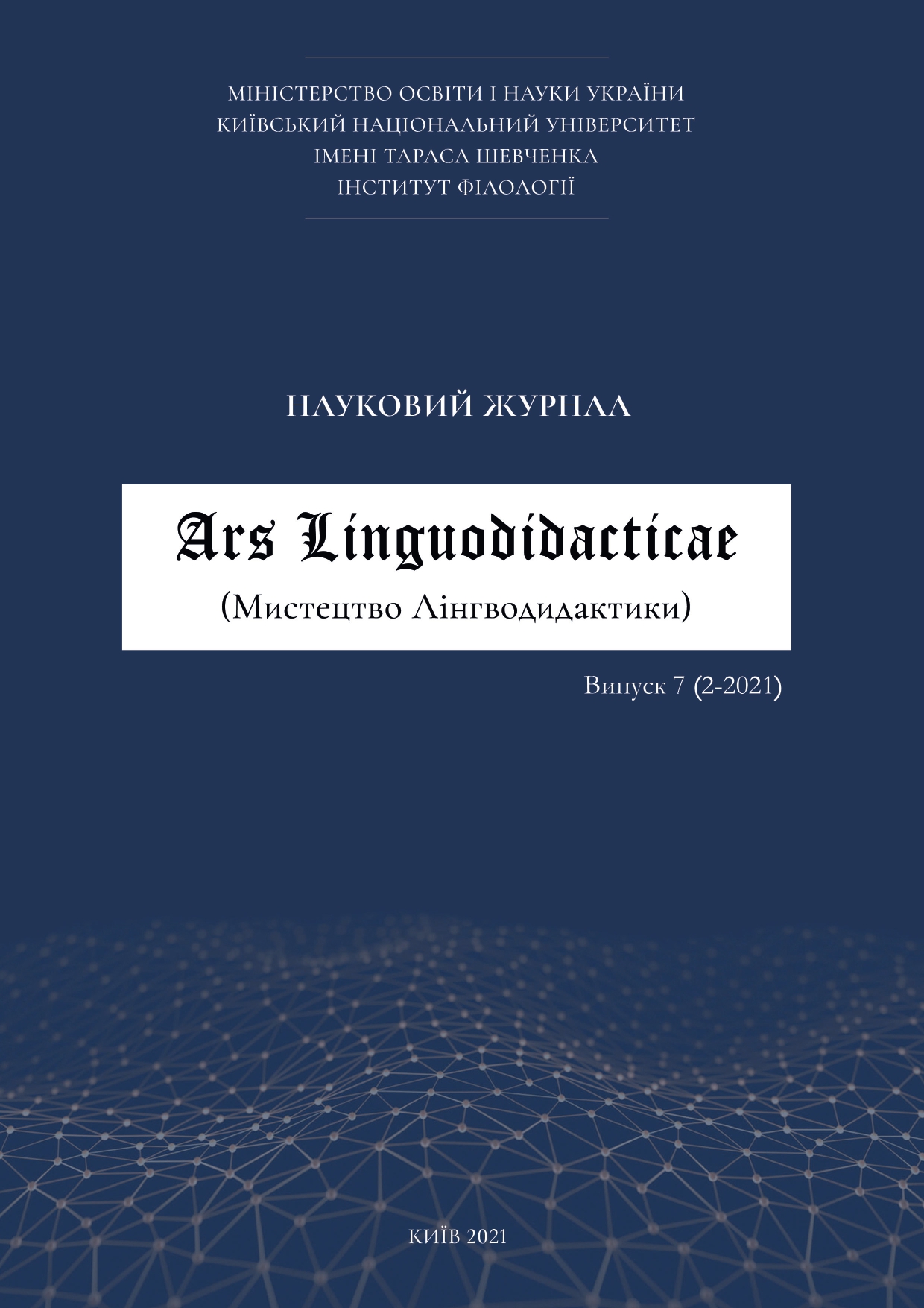ВИЗНАЧЕННЯ ЛЕКСИКО-СЕМАНТИЧНОГО ПОЛЯ ТА ТИПІВ ВІДНОШЕНЬ ЛЕКСИЧНИХ ОДИНИЦЬ З ПОЗИЦІЙ КОГНІТИВНОГО ПІДХОДУ У ПРОЦЕСІ НАВЧАННЯ ІНОЗЕМНОЇ МОВИ СТУДЕНТІВ ФІЛОЛОГІЧНОГО НАПРЯМКУ
DOI:
https://doi.org/10.17721/2663-0303.2021.7.03Анотація
У статті визначено теоретико-методологічні засади навчання іноземної мови студентів ЗВО з позицій когнітивного підходу. Подано узагальненні визначення понять «лексико-семантичне поле», «категоризація», «концептуалізація», «поняттєва категорія» і «семантична категорія» та систематизовано
підходи до визначення функціонально-семантичного, граматичного, словотворчого, або морфосемантичного та лексичного полів для засвоєння студентами у процесі навчання другої мови. Запропоновано
організовувати процес розуміння та оволодіння ключовими категоріями лінгвістики у такому порядку:
аналіз лексико-семантичного поля, деталізація лексико-семантичної групи слів, визначення однакової
для всіх членів лексико-семантичного поля одиниці – семи (семантичниого компоненту). Студентам
для успішного оволодіння другою мовою необхідно розрізняти семантичні категорії та поняттєві, а також враховувати особливості вираження їх змісту у певній знаковій формі. Оскільки метонімія й метафора належать до одних з найпродуктивніших способів збагачення мови, когнітивний розвиток мовної
особистості студентів передбачає усвідомлення референтів, корелятів та фокусів і контекстів метафоричних та метонімічних мовних знаків. Передбачено, що шляхом розгляду семантичних відношень,
в яких можуть існувати лексико-семантичні поля в іноземній мові, студенти навчаються ефективно
аналізувати метафоричне перенесення значення, яке тісно пов’язане з полісемією і синонімією.
Ключові слова: когнітивний підхід у навчанні іноземної мови, розвиток мовної особистості студента, лексико-семантичне поле, семантичні та поняттєві категорії.
##submission.downloads##
Опубліковано
Як цитувати
Номер
Розділ
Ліцензія
Авторське право (c) 2021 Зоя Корнєва, Тетяна Кириленко

Ця робота ліцензується відповідно до Creative Commons Attribution-ShareAlike 4.0 International License.
Ця робота ліцензується відповідно до Creative Commons Attribution-NonCommercial 4.0 International License.
Політика охорони авторських прав відповідно до умов ліцензії: Creative Commons Attribution-NonCommercial (Атрибуція-Некомерційне використання) 4.0 Міжнародна (CC BY-NC 4.0).
Автори, що публікують свої статті в журналі "Ars Linguodidacticae" (журналі відкритого доступу) зберігають за собою такі права:
- Автори зберігають за собою права на авторство своєї статті та надають журналу "Ars Linguodidacticae" право першої публікації рукопису своєї статті на умовах ліцензії Creative Commons (CC BY-NC 4.0) Attribution License, яка дозволяє іншим особам вільно розповсюджувати опубліковану роботу з обов'язковим посиланням на автора оригінальної роботи та першу оригінальну публікацію в журналі "Ars Linguodidacticae". Інформація про збереження права на авторство надається на титульній сторінці статті.
- Автори зберігають за собою право укладати окремі угоди на неексклюзивне розповсюдження своєї статті у тому вигляді, в якому вона була опублікована в журналі "Ars Linguodidacticae" (наприклад, розміщувати статтю в електронних бібліотеках, архівах та каталогах або публікувати у складі інститутських збірників та монографій), за умови обов'язкового повного посилання на першу оригінальну публікацію в журналі "Ars Linguodidacticae".
- Політика журналу "Ars Linguodidacticae" дає змогу та заохочує розміщення авторами в мережі Інтернет (наприклад в інститутському репозитарії або на персональному сайті) рукопису роботи як до її подання до редакції, так і під час її редакційного опрацювання, оскільки це сприяє продуктивній науковій дискусії та позитивно позначається на оперативності й динаміці цитування статті.
Редакція журналу зберігає за собою видавничі права на:
- зверстані оригінали статей та весь номер журналу;
- оформлення журналу, а також оригінальні ілюстративні та додаткові матеріали;
- репринтні перевидання журналу в друкованому та електронному вигляді.
Політика охорони авторських прав провадиться відповідно до умов ліцензії: Creative Commons Attribution-NonCommercial (Атрибуція-Некомерційне використання) 4.0 Міжнародна (CC BY-NC 4.0).
Для отримання додаткової інформації, будь ласка, прочитайте повний текст Публічної ліцензії CC BY-NC 4.0
Creative Commons Attribution-NonCommercial 4.0 International License.


